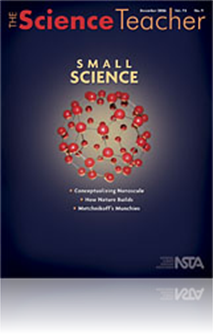All The Science Teacher resources
Journal Article
The Experts address the following question in this month’s column: "Since helium is an inert gas that drifts to space, where do we get the helium that we use here on Earth for balloons and other applications?"...
Journal Article
One strategy for enhancing students’ understanding of nanoscale is to shift students’ existing understandings of relative scale by helping them conceptually transport their strongest scale benchmark—themselves—into the nanoscale world. This a...
Journal Article
Idea Bank: Students as Nano-Detectives
Nanotechnology is quickly beginning to revolutionize medicine, building materials, electronics, and even the clothes we wear. The internet offers a plethora of information, images, and interactive simulations dealing with the world at a nanoscale lev...
Journal Article
The black box activity described in this article, created as part of the National Science Foundation-funded Internships in Public Science Education Program (IPSE) at the University of Wisconsin—Madison, introduces students to the idea of remote ima...
Journal Article
Career of the Month: An interview with Ear, Nose, Throat Doctor Scott Howard
Ear, nose, and throat complaints, such as allergies, ear infections, sinusitis, and sore throats, are the number one reason people go to the doctor. Diseases and disorders of the head and neck, particularly the ear, nose, and throat (ENT), are treate...
Journal Article
Many microscopy activities used in classrooms involve observations of structures in cells and organisms, and in research the microscope is an important and powerful tool for investigating cellular processes. To introduce high school students to exper...
Journal Article
Using technology to Blend Teaching and Basic Research
The CHANCE (Connecting Humans and Nature in the Costa Rican Environment) program is a coordinated effort between The Pennsylvania State University (PSU) and the Pennsylvania Department of Education (PDE) that trains 9th- through 12th-grade teachers ...



